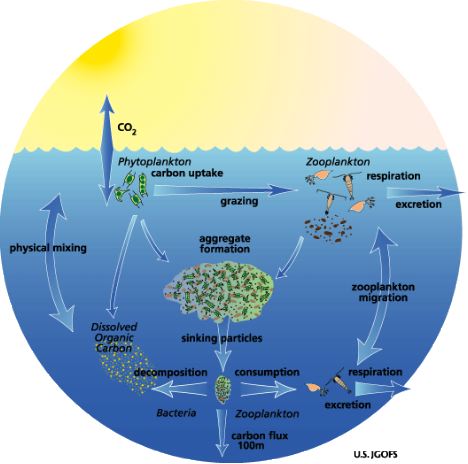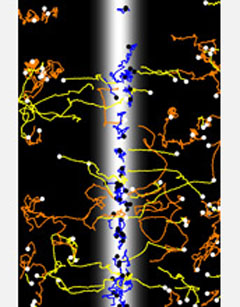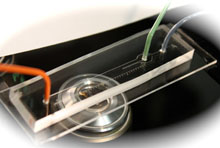Navigation
Tiny Marine Microbes Exert Influence on Global Climate
New research indicates that the interactions of microscopic organisms around a particular organic material may alter the chemical properties of the ocean--influencing global climate by affecting cloud formation in the atmosphere.
New research indicates that the interactions of microscopic organisms around a particular organic material may alter the chemical properties of the ocean--influencing global climate by affecting cloud formation in the atmosphere.
Justin Seymour, a research fellow at the University of Technology Sydney, is the lead author of a paper reporting the results, published in this week's issue of the journal Science.
 |
| Marine scientists have discovered 'chemoattraction' throughout the ocean's microbial food webs. Credit: U.S. Joint Global Ocean Flux Study (JGOFS) |
The paper describes how a relative of the chemical that seabirds and seals use to locate prey, dimethylsulfide (DMS), may serve a similar purpose at the microbial scale, helping marine microorganisms find food and cycle chemicals that are important to climate.
 |
| Trajectories of Oxyrrhis marina, a marine plankton, are shown in a patch of DMSP. Yellow trajectories represent individuals with the fastest response; blue trajectories are individuals within the patch, and orange denotes all other trajectories. Circles indicate the starting point of each trajectory. Credit: Roman Stocker and Tanvir Ahmed |
"These scientists have used impressive technology to study interactions between organisms and their chemical environment at the scales they actually take place," said David Garrison, director of the National Science Foundation (NSF)'s biological oceanography program, which funded the research.
"The research will give us new insights on the workings of microbial assemblages in nature."
Seymour agrees. "We found that ecological interactions and behavioral responses taking place within volumes of a fraction of a drop of seawater can ultimately influence important ocean chemical cycling processes."
Using microfluidic technology, the team of researchers, led by Roman Stocker of the Massachusetts Institute of Technology, recorded microbes swimming toward the chemical dimethylsulfoniopropionate (DMSP) as it was released into a tiny channel occupied by the microbes.
The fact that the microbes actively moved toward the DMSP indicates that the tiny organisms play a role in ocean sulphur and carbon cycles, which exert a powerful influence on Earth's climate.
How fast the microorganisms consume DMSP--rather than converting it into DMS--is important because DMS is involved in the formation of clouds in the atmosphere.
This in turn affects the heat balance of the atmosphere.
Seymour, Stocker, Rafel Simó of the Institute for Marine Sciences in Barcelona, and MIT graduate student Tanvir Ahmed carried out the research in Stocker's MIT laboratory.
The study is the first to make a visual record of microbial behaviour in the presence of DMSP.
"It's important to be able to directly look at an environment in order to understand its ecology," Stocker said.
"We can now visualize the behavior of marine microorganisms much like ecologists have done with macro-organisms for a long time."
 |
| An image of the microchannel used in the scientists' experiments. Credit: Tanvir Ahmed and Roman Stocker |
To accomplish this, the team recreated a microcosm of the ocean environment using a microfluidic device about the size of a flash drive with minuscule channels engraved in a clear rubbery material.
The scientists injected DMSP into the channel in a way that mimics the bursting of an algal cell after viral infection--a common event in the ocean--then, using a camera attached to a microscope, they recorded whether and how microbes swam toward the chemical.
The researchers found that some marine microbes, including bacteria, are attracted to DMSP because they feed on it, whereas others are drawn to the chemical because it signals the presence of prey.
This challenges previous theories that this chemical might be a deterrent against predators.
"Our observations clearly show that, for some plankton, DMSP acts as an attractant towards prey rather than a deterrent," said Simó.
"By simulating the microscale patches of the chemical cue and directly monitoring the swimming responses of the predators towards these patches, we get a much more accurate perception of these important ecological interactions than can be obtained from traditional bulk approaches."
The research also indicates that marine microorganisms have at least one behavioral characteristic in common with larger sea and land animals: we're all drawn to food.
In next steps, the team plans to extend the research from the laboratory to the ocean environment.
The scientists are working on an experimental system that can be used on oceanographic ships working with bacteria collected directly from the ocean.
The research was also funded by the Australian Research Council, the Spanish Ministry of Science and Innovation, La Cambra de Barcelona, and the Hayashi Fund at MIT.
This news is from the National Science Foundation, 15 July 2010.
Video showing microorganisms responding rapidly to a patch of dimethylsulfoniopropionate(DMSP).
Marine microbes--though invisible to the naked eye--perform functions that are vital for the health of the ocean. With no vision or hearing, they navigate their environment by following chemical signals. One of these chemicals, DMSP, elicits attraction among several marine microorganisms. The movies, taken in microfluidic channels, show the predator Oxyrrhis marina responding rapidly to a patch of DMSP, then retaining position within the patch. Credit: Roman Stocker, Tanvir Ahmed, Rafel Simó, Justin Seymour (MIT)
Search
Latest articles
Agriculture
- World Water Week: Healthy ecosystems essential to human health: from coronavirus to malnutrition Online session Wednesday 24 August 17:00-18:20
- World Water Week: Healthy ecosystems essential to human health: from coronavirus to malnutrition Online session Wednesday 24 August 17:00-18:20
Air Pollution
- "Water and Sanitation-Related Diseases and the Changing Environment: Challenges, Interventions, and Preventive Measures" Volume 2 Is Now Available
- Global Innovation Exchange Co-Created by Horizon International, USAID, Bill and Melinda Gates Foundation and Others
Biodiversity
- It is time for international mobilization against climate change
- World Water Week: Healthy ecosystems essential to human health: from coronavirus to malnutrition Online session Wednesday 24 August 17:00-18:20
Desertification
- World Water Week: Healthy ecosystems essential to human health: from coronavirus to malnutrition Online session Wednesday 24 August 17:00-18:20
- UN Food Systems Summit Receives Over 1,200 Ideas to Help Meet Sustainable Development Goals
Endangered Species
- Mangrove Action Project Collaborates to Restore and Preserve Mangrove Ecosystems
- Coral Research in Palau offers a “Glimmer of Hope”
Energy
- Global Innovation Exchange Co-Created by Horizon International, USAID, Bill and Melinda Gates Foundation and Others
- Wildlife Preservation in Southeast Nova Scotia
Exhibits
- Global Innovation Exchange Co-Created by Horizon International, USAID, Bill and Melinda Gates Foundation and Others
- Coral Reefs
Forests
- NASA Satellites Reveal Major Shifts in Global Freshwater Updated June 2020
- Global Innovation Exchange Co-Created by Horizon International, USAID, Bill and Melinda Gates Foundation and Others
Global Climate Change
- It is time for international mobilization against climate change
- It is time for international mobilization against climate change
Global Health
- World Water Week: Healthy ecosystems essential to human health: from coronavirus to malnutrition Online session Wednesday 24 August 17:00-18:20
- More than 400 schoolgirls, family and teachers rescued from Afghanistan by small coalition
Industry
- "Water and Sanitation-Related Diseases and the Changing Environment: Challenges, Interventions, and Preventive Measures" Volume 2 Is Now Available
- Global Innovation Exchange Co-Created by Horizon International, USAID, Bill and Melinda Gates Foundation and Others
Natural Disaster Relief
- STOP ATTACKS ON HEALTH CARE IN UKRAINE
- Global Innovation Exchange Co-Created by Horizon International, USAID, Bill and Melinda Gates Foundation and Others
News and Special Reports
- World Water Week: Healthy ecosystems essential to human health: from coronavirus to malnutrition Online session Wednesday 24 August 17:00-18:20
- STOP ATTACKS ON HEALTH CARE IN UKRAINE
Oceans, Coral Reefs
- World Water Week: Healthy ecosystems essential to human health: from coronavirus to malnutrition Online session Wednesday 24 August 17:00-18:20
- Mangrove Action Project Collaborates to Restore and Preserve Mangrove Ecosystems
Pollution
- Zakaria Ouedraogo of Burkina Faso Produces Film “Nzoue Fiyen: Water Not Drinkable”
- "Water and Sanitation-Related Diseases and the Changing Environment: Challenges, Interventions, and Preventive Measures" Volume 2 Is Now Available
Population
- "Water and Sanitation-Related Diseases and the Changing Environment: Challenges, Interventions, and Preventive Measures" Volume 2 Is Now Available
- "Water and Sanitation-Related Diseases and the Changing Environment: Challenges, Interventions, and Preventive Measures" Volume 2 Is Now Available
Public Health
- Honouring the visionary behind India’s sanitation revolution
- Honouring the visionary behind India’s sanitation revolution
Rivers
- World Water Week: Healthy ecosystems essential to human health: from coronavirus to malnutrition Online session Wednesday 24 August 17:00-18:20
- Mangrove Action Project Collaborates to Restore and Preserve Mangrove Ecosystems
Sanitation
- Honouring the visionary behind India’s sanitation revolution
- Honouring the visionary behind India’s sanitation revolution
Toxic Chemicals
- "Water and Sanitation-Related Diseases and the Changing Environment: Challenges, Interventions, and Preventive Measures" Volume 2 Is Now Available
- Actions to Prevent Polluted Drinking Water in the United States
Transportation
- "Water and Sanitation-Related Diseases and the Changing Environment: Challenges, Interventions, and Preventive Measures" Volume 2 Is Now Available
- Urbanization Provides Opportunities for Transition to a Green Economy, Says New Report
Waste Management
- Honouring the visionary behind India’s sanitation revolution
- Honouring the visionary behind India’s sanitation revolution
Water
- Honouring the visionary behind India’s sanitation revolution
- Honouring the visionary behind India’s sanitation revolution
Water and Sanitation
- Honouring the visionary behind India’s sanitation revolution
- Honouring the visionary behind India’s sanitation revolution

